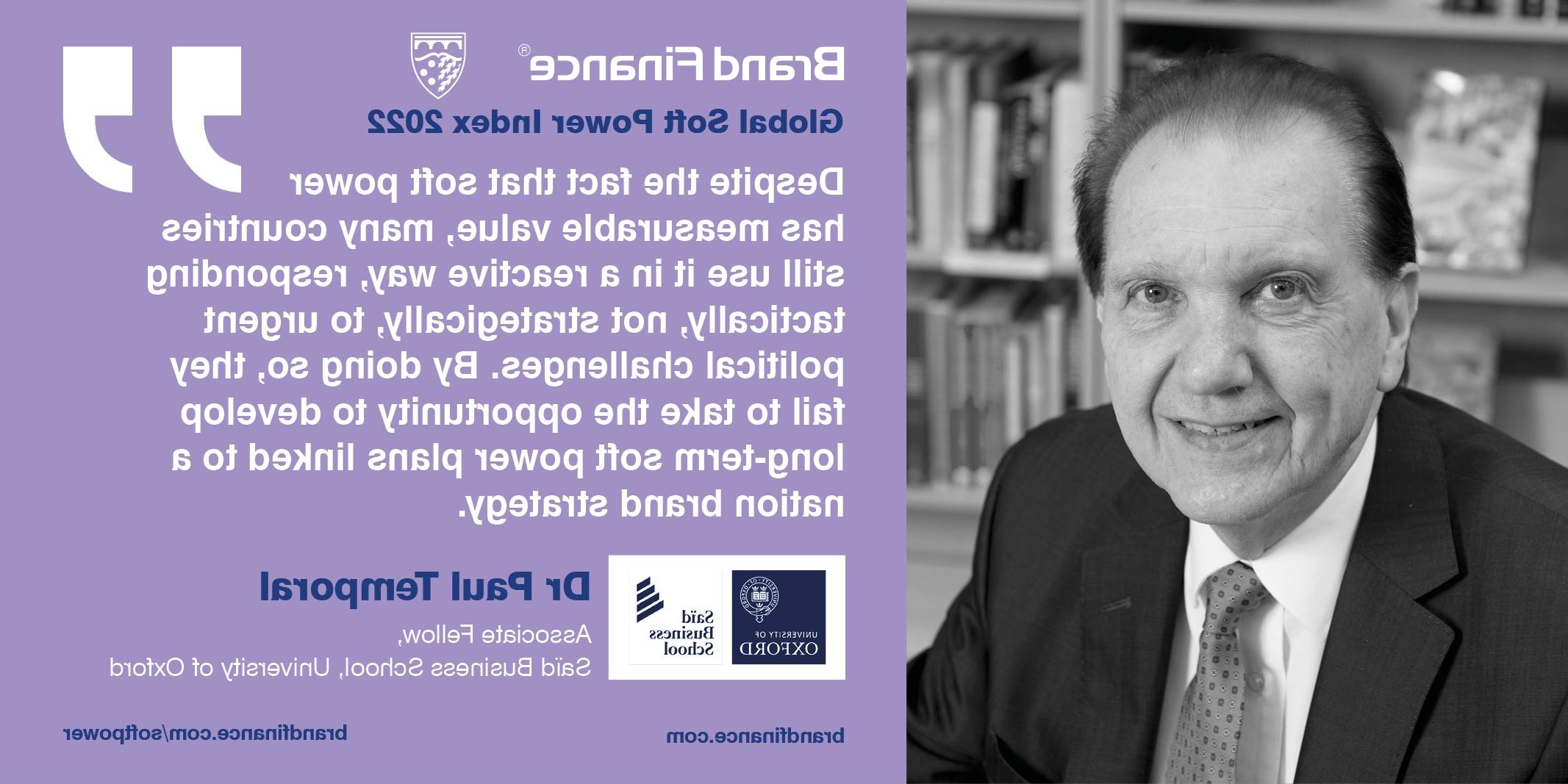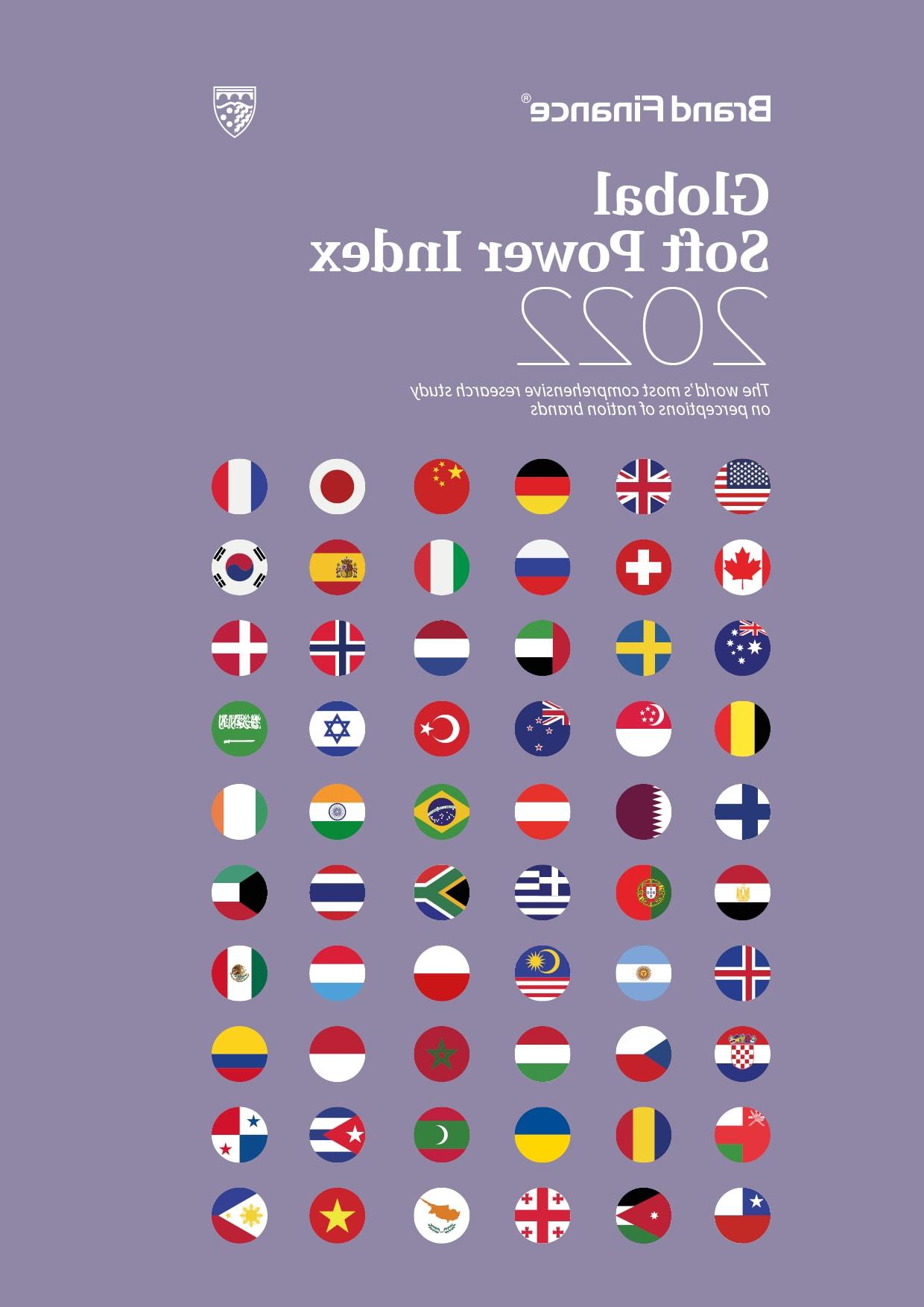Este artigo foi publicado originalmente no ÍNDICE DE SOFT GLOBAL 2022.

Poucos países têm uma estratégia de marca nacional integrada, que é limitada. As estruturas inadequadas de gerenciamento de marcas são parcialmente os culpados. Uma marca nacional forte e positiva incentiva o investimento interno e o crescimento das exportações; Atrai turistas e talentos. O poder suave, por outro lado, é a capacidade de persuadir e influenciar, principalmente na arena internacional. Pode ser um forte impulsionador do sucesso da marca nacional em todos os níveis, e oito dos 10 principais países do Índice Global de Power Soft Power 2022 também aparecem no Índice de Marca da Nação 2021 Top Ten. Ao fazer isso, eles não aproveitam a oportunidade para desenvolver planos de energia soft de longo prazo vinculados a uma estratégia de marca nacional. de submarcas e marcas de produtos. Portanto, deve estar no setor público, pois todas as marcas ganham confiança, força e valor ao longo do tempo. E, tendo começado nessa trajetória, eles inevitavelmente continuam com uma abordagem de submarca setor por setor. Isso pode levar à concorrência entre submarcas pelo investimento e o "ouvido" do governo, que geralmente resulta em desperdício e/ou duplicação de financiamento de investimentos. Pode até haver concorrência em submarcas e marcas de produtos, como turismo nacional, turismo estadual ou turismo para destinos da cidade e do local.
Nation branding is concerned largely with the effect of a country’s image on the economy. A strong, positive nation brand encourages inward investment and export growth; it attracts tourists and talent. Soft Power, on the other hand, is the ability to persuade and influence, mainly in the international arena. It can be a strong driver of nation branding success at all levels, and eight of the top 10 countries in the Global Soft Power Index 2022 appear also in the Nation Brand Index 2021 top ten.
Despite the fact that soft power has measurable value, many countries still use it in a reactive way, responding tactically, not strategically, to urgent political challenges. By doing so, they fail to take the opportunity to develop long-term soft power plans linked to a nation brand strategy.

There are two main reasons why this happens: the wrong choice of brand architecture and inadequate brand management structure.
In the corporate world, it is established practice to develop a master brand strategy and link this to an ‘architecture’ of sub-brands and product brands. So it should be in the public sector, as all brands then gain trust, strength, and value over time.
What we find, though, is that most countries start to build a nation brand identity based on only one sector – often tourism, which is the most visible and measurable activity. And, having started on this trajectory, they inevitably continue with a sector-by-sector, sub-brand approach. This can lead to competition between sub-brands for investment and the ‘ear’ of government, which often results in wastage and/or duplication of investment funding. There can even be competition within sub-brands and product brands such as national tourism, state tourism, or tourism to city and place destinations.
Então, por que isso acontece? Eu acho que uma estratégia de marca nacional abrangente é frequentemente vista como 'missão impossível'; Envolver todas as partes interessadas e de acordo com o desenvolvimento e a implementação parece muito difícil. O pensamento político e os orçamentos do governo são de curto prazo, impulsionados pela necessidade de demonstrar retornos do investimento e melhoria nos mercados ferozmente competitivos. Uma estrutura com o poder de afetar a mudança, a inclusão e uma duração ampla. Houve alguns modelos úteis que testemunham o sucesso do gerenciamento estruturado da marca, como os da Coréia do Sul, Suíça e Austrália. Como apelo cultural, governança, demanda por exportações e outros, embora a Coréia tenha sido a 13
Further, developing and managing a nation brand is a long-term process, with results also taking a long time to appear. Political thinking and government budgets are short term, driven by the need to demonstrate returns on investment and improvement in fiercely competitive markets.
But the only way to build a powerful nation brand is to use the master brand approach, and the most effective way to accommodate this is to create a strong, powerful, and inclusive brand management structure at a high level; a structure with the power to effect change, inclusivity, and a broad remit. There have been some useful models that testify to the success of structured brand management such as those in South Korea, Switzerland, and Australia.
The South Korean Presidential Council on Nation Branding (PCNB) was founded in 2009 as a result of a nation brand research study that ranked Korea 39th, behind countries including Mexico, India, China and Egypt on various brand strength factors such as cultural appeal, governance, demand for exports and others, even though Korea was the 13 th economia mais poderosa do mundo. Ele desempenhou um papel central na reorganização e gerenciamento das atividades de marca da Coréia do Sul e na criação de imagens positivas no exterior. Com uma visão da marca nacional de “uma Coréia confiável e digna” e valores centrais de “compartilhamento, consideração, respeito, comunicação e unidade”, sua estratégia foi projetada também para reforçar e desenvolver poder suave. A Coréia do Sul está agora classificada em 12
PCNB comprised 47 members (16 senior government officials including eight Ministers, and 31 representatives from the private sector), with five teams responsible for international co-operation, corporate and information technology, culture and tourism, the global community, and overall co-ordination. It played a central role in reorganizing and managing South Korea's branding activities and creating positive images abroad. With a nation brand vision of “A Reliable and Dignified Korea” and core values of “Sharing, Consideration, Respect, Communication and Unity”, its strategy was designed also to reinforce and develop soft power. South Korea is now ranked 12 th no GSPI 2022 e 10 th no NBI 2021.
Austrália tem um ministro para o comércio, o turismo e o investimento e este portfólio integrado é útil na redução da concorrência intra-brand e do indústrias de compactação e seguros em todos os que estão em busca de computação e seguinte. A reportagem ao ministro é um Conselho Consultivo da Marca Nacional cujo papel é fornecer conselhos e liderança estratégica e é composto por 12 líderes influentes do setor público e privado de diversas indústrias. O Conselho é apoiado por um grupo de trabalho especialista em branding nacional que fornece orientação criativa e de marca, portanto, concluindo uma estrutura de gerenciamento de marcas de nação viável. Australia is 13th in the GSPI 2022 and 11th in the NBI 2021.
Switzerland does not have a hugely powerful economy compared to some nations, and so relies for its nation brand development heavily on soft power, through Presence Switzerland, a body that monitors and supports the national identidade e imagem no exterior. Foi criado pelo Parlamento Federal Suíço em 2000 como uma unidade administrativa descentralizada dentro do Departamento Federal de Relações Exteriores (FDFA) e recebeu autoridade pela Lei Federal sobre a promoção da imagem da Suíça no exterior. A Suíça está classificada 8 TH no GSPI e 14 th no NBI. De acordo com a metodologia NBI 2021, a Suíça foi nomeada a marca mais forte do mundo. O gerenciamento de marca bem organizado é essencial para navegar nessas águas complicadas, e deve haver adesão, controle, consistência e medição multissetoriais. Os casos mencionados destacam a necessidade de dirigir e gerenciar a marca de uma nação no mais alto nível e incluir todas as partes interessadas em seu desenvolvimento e gerenciamento. Não é uma tarefa impossível. Temporal: Soft Power and Nation Branding: Strategy & Struction
If poor brand architecture choices and lack of strong brand management are barriers to success, then countries must combine nation branding and soft power data and activities for use in developing an integrated nation-brand strategy. Well-organised brand management is essential to navigate these tricky waters, and there must be multi-sector buy-in, control, consistency, and measurement. The cases mentioned highlight the need to drive and manage a nation’s brand at the highest level, and to include all stakeholders in its development and management. It is not an impossible task.
